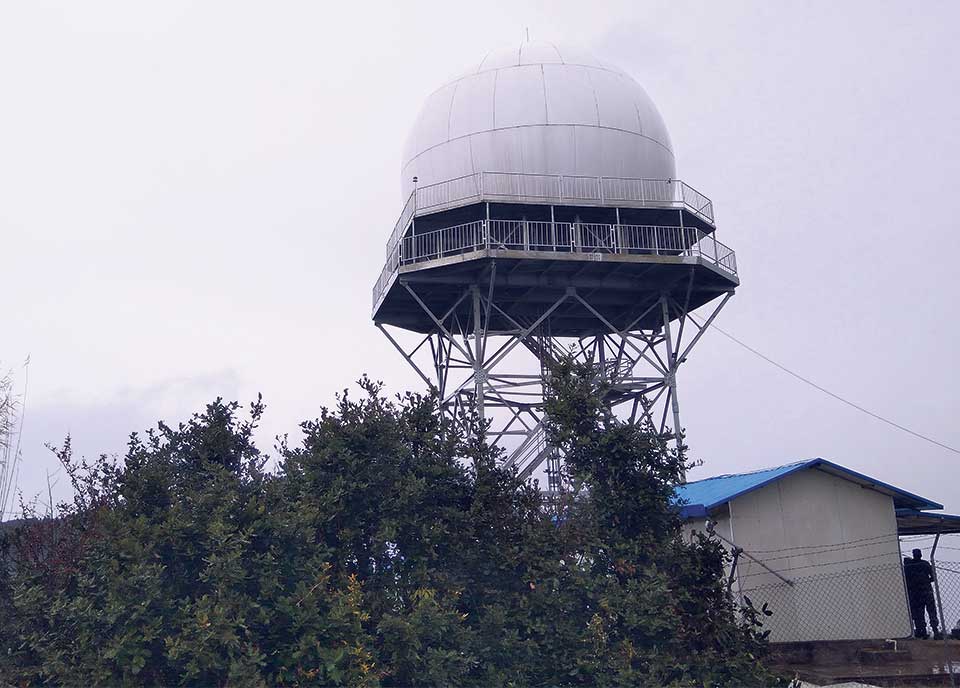
OR
New radar system to be operational from Feb 1
Published On: January 25, 2018 07:30 AM NPT By: Arpana Ale Magar

KATHMANDU, Jan 25: Civil Aviation Authority of Nepal (CAAN) is starting full-fledged operation of Mode S Monopulse Secondary Surveillance Radar (MSSR), which was installed at Bhattedanda of Lalitpur 14 months ago, from February 1.
In order to ensure safer and more efficient aircraft operations in Nepal, CAAN, with the financial and technical assistance of Japan International Cooperation Agency (JICA), has installed En-route Monopulse Secondary Surveillance Radar (E-MSSR) at Bhattedanda of Lalitpur and Terminal Monopulse Secondary Surveillance Radar (T-MSSR) at Tribhuvan International Airport (TIA).
During the monitoring of radar test on Wednesday, Jun Sakuma, chief representative of JICA Nepal, said that the new radar system will improve safety of aircraft flying in Kathmandu Flight Information Region (FIR) through continuous monitoring and control. “The new T-MSSR installed at TIA has capacity of 200 nautical miles, while the Enroute-MSSR installed at Bhattedanda has coverage of 250 nautical miles,” he added.
According to Sakuma, the new radar will cover almost all international flights while it will cover around 97 percent of domestic flights. “It will increase air space capacity and control the air traffic in an easier manner than the previous one,” he added.
The new radar surveillance system will cover the speed, height and distance of aircrafts up to Surkhet in the mid-western region and the entire eastern region.
Sanjeev Singh Kathayat, project director of the new radar surveillance system, however, said that the new radar system will not cover the high Himalayan region. “This radar is the latest generation of radar system. It has precise identification capabilities as well as the capacity of selective interrogation,” Kathayat said, adding that it gives an accurate position of the aircraft as well as can identify almost 17 million aircraft.
The existing radar system has the capacity to identify only 4096 aircraft.
“These days the movement of aircraft is increasing day by day and so does the air traffic,” Kathayat said, adding: “So to address this situation, the new radar will help to control the air traffic by monitoring the distance and speed of the aircraft.”
The new radar system can monitor altitude, speed and distance of aircraft, as well as provide vectoring and separation service, he added.
Air Traffic Controllers (ATCs) also said that the new system will help them to monitor speed, altitude and distance of the aircraft. “The new system will make it easier for us to keep the aircraft in holding pattern. It will lessen our work stress a lot,” an ATC at TIA told Republica. “With the new system in place, aircraft cannot fake their position. We can monitor their position as well as connect with them individually.”
Earlier, ATCs were finding it difficult to connect with all aircraft at the same time.
During a site visit to Bhattedanda on Wednesday, Japanese ambassador to Nepal, Masashi Ogawa, expressed hope that the second generation of radar system in Nepal will help to improve aviation safety in the country.
Similarly, CAAN Director General Sanjeev Gautam said that the aviation sector regulator was planning to install a new radar system in Bhairahawa.
CAAN is operating the new radar in trial phase at present. Though the new system will formally come into operation on February 1, CAAN intends to operate the existing system as a backup for the time being. “The new system is ready for operation. But we are still making some safety assessments which will take at least two or three months. Till then, the old system will work as a backup.”
The radar installation project began in 2013 with investment of Rs 1 billion. The installation was expected to be completed by 2015. However, the 2015 earthquakes and economic blockade by India affected installation works, according to officials.
JICA handed over the project to CAAN in October, 2016. CAAN completed the remaining works in December, 2016. CAAN conducted successful flight inspection using the new radar system in November, 2017.
You May Like This

CAAN begins inspection of new radar system from Bhatte Danda
KATHMANDU, Nov 19: Civil Aviation Authority of Nepal (CAAN) has conducted a flight inspection of Mode S Monopulse Secondary Surveillance Radar... Read More...

2nd generation radar installed to make air service safe and reliable
KATHMANDU, Feb 1: The Civil Aviation Authority of Nepal has brought second generation (2G) radar into operation officially from today. ... Read More...

Students should be at the heart of education system
Nepal’s education system needs radical reform. Our system focuses on just the scores than practical knowledge. Just measuring scores of... Read More...




Just In
- MoHP cautions docs working in govt hospitals not to work in private ones
- Over 400,000 tourists visited Mustang by road last year
- 19 hydropower projects to be showcased at investment summit
- Global oil and gold prices surge as Israel retaliates against Iran
- Sajha Yatayat cancels CEO appointment process for lack of candidates
- Govt padlocks Nepal Scouts’ property illegally occupied by NC lawmaker Deepak Khadka
- FWEAN meets with President Paudel to solicit support for women entrepreneurship
- Koshi provincial assembly passes resolution motion calling for special session by majority votes







_20220508065243.jpg)






Leave A Comment